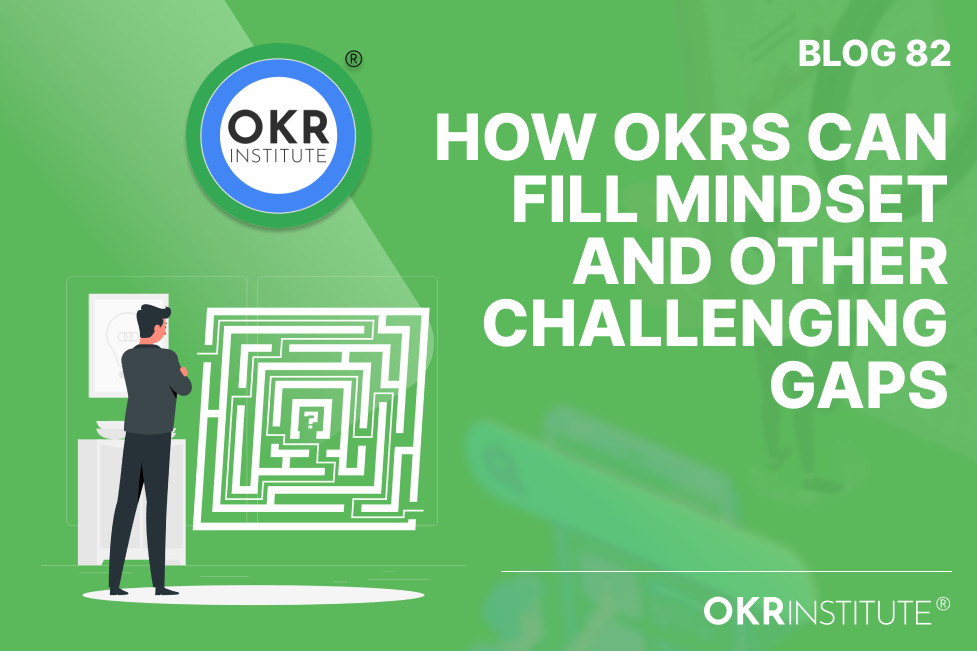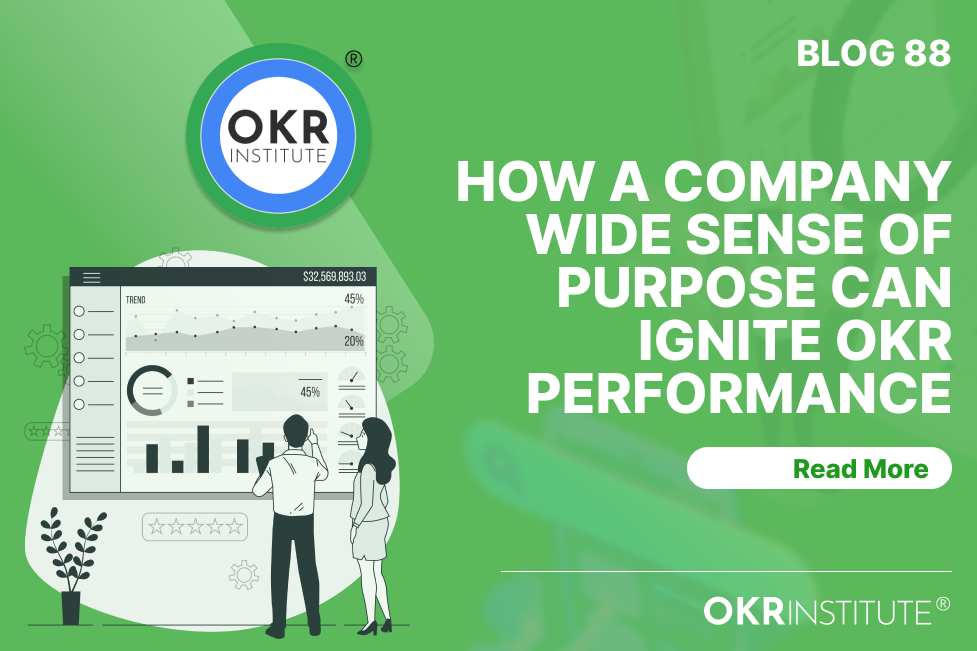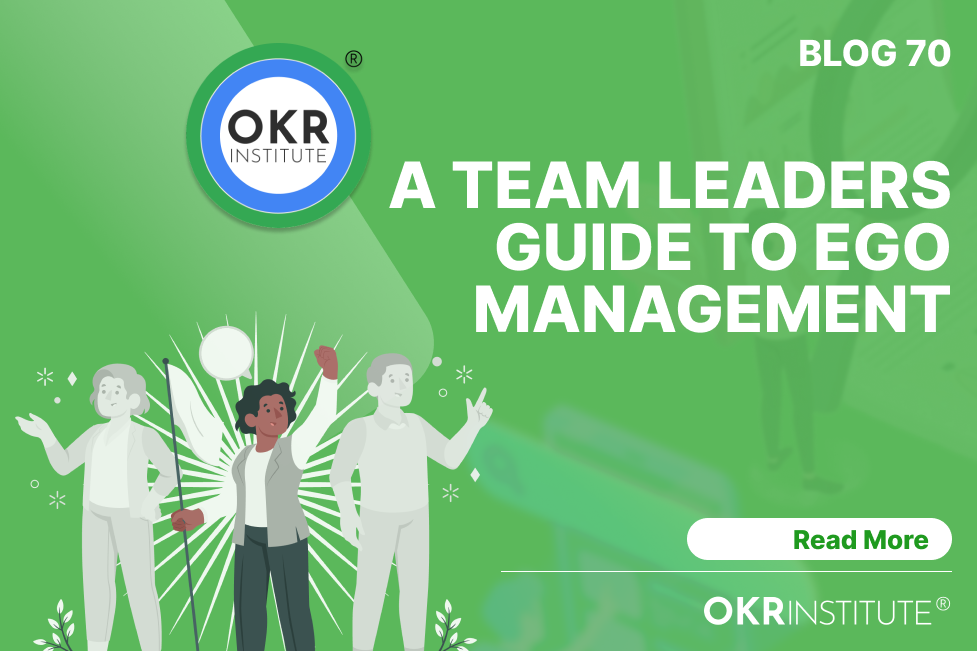How OKRs can Fill Mindset and other challenging Gaps

How OKRs can fill mindset and other challenging gaps
“Fixed mindset makes you concerned with how you’ll be judged; the growth mindset makes you concerned with improving.”
Caroline S. Dweck
OKRs will not fill every gap in the organization nor will they solve all your problems yet they can most certainly have an immense positive impact on specific challenges and gaps when effectively deployed:
Mindset Gaps
The mindset with which strategies are created at the company’s highest level often differs from those who have to execute the same techniques. When those tasked with strategy execution question strategies, this is often viewed as resistance to change. This is one of several reasons why most companies must execute their strategy more effectively.
As the OKR framework is an agile goals-setting methodology, we can fill the ‘strategy and execution gap’ and set strategies ‘the agile way.’ By co-creating strategies and including team members’ voices, we can bring more transparency and understanding to the strategy and simplify it.
The most productive mindset orientation to actualize OKRs is a growth mindset. When team members suffer from a fixed mindset orientation, it becomes even more challenging to achieve OKRs. A fixed mindset orientation makes you concerned about how you will be judged and makes you believe that the limits to your potential and performance that you have set in your mind are real and concrete boundaries.
As the saying goes, ‘Do not get bitter, get better.’ A growth mindset makes you think that failures are learning opportunities to be transformed into positive growth. When you have a fixed mindset orientation, you are more likely to see only problems and not come up with solutions.
A growth mindset orientation does not include ignorance of problems but instead shifts the focus to solution-driven thinking and a collaborative approach to problem-solving. By being insatiably curious and bringing that curiosity (how can we achieve goals jointly, how can we best do this?) to OKR meetings, we can jointly achieve great things.
THE strategy and Execution Gap
By its very nature OKR frameworks are ideally suited to filling the strategy and execution gap, because:
- Objectives are aligned to the strategy/strategies of the company when effectively drafted.
- The action plan designed to actualize the key results within an OKR framework places the focus on execution.
- When multiple strategic and team-level OKRs align with the company’s strategy/strategies, all involved move coherently towards actualizing the vision and strategy.
The ‘Tyranny of the Tangible’ Gap
What is customary, tangible and tradition tend to make us comfortable The longer the habit of staying within the ‘self-inflicted boundaries’ of your comfort zone is maintained the harder it becomes to pursue ‘stretch goals’.
Often, when the results of an OKR implementation are viewed as poor by top management, their knee-jerk reaction can be to revert to what is tangible and a ‘command-control environment. That is why it is critical to do thorough research, create a strategic roll-out plan, and ensure a complete OKR education in your organization. It is also essential how you communicate around OKRs:
- Is it clear to all in the organization why we are doing an OKR roll-out?
- Is it clear to all what success looks like?
- Is it clear what my and my team’s expectations are?
By ensuring that all the elements of a successful OKR implementation are thoroughly focused on we can fill the ‘tyranny of the tangible gap’ through OKRs
Skills Gaps
In comparing our current status to the desired future goal (OKR), it may be revealed that some skills gaps need to be addressed for us to actualize the OKR that we have set as a team.
After drafting an OKRor OKR, we can closely work with our HR team to assess skill gaps. Based on those identified skill gaps, we can offer targeted and immersive learning experiences to fill those skill gaps or hire people with the required skills. This would depend on what the situation demands.
‘Your OKRs are only as good as your skills’ – We can draft outcome-focused OKRs aligned with the company’s strategy and vision, but if we ignore the potential skills gaps that stand between us as a team and OKR achievement, we are likely to to struggle to gain forward momentum on our OKRs.
Strong leadership is required to fill all of the above gaps. It is a skill in itself to identify and overcome these gaps. Identifying skill gaps and overcoming them can be simplified through collaborative efforts and by making the OKR setting process very transparent.
FAQs
Q1: How can OKRs help bridge the gap between strategy and execution in my organization?
A1: OKRs help bridge the strategy and execution gap by aligning objectives with the company’s strategic goals. They ensure that every team member understands their role in achieving these goals. By fostering a collaborative environment where team members contribute to strategy creation, OKRs promote transparency and simplify the execution process. This alignment ensures everyone moves coherently towards actualizing the company’s vision and strategy.
Q2: What is the difference between a fixed mindset and a growth mindset, and how does it impact OKR achievement?
A2: A fixed mindset is characterized by a concern with how one is judged and the belief that abilities are static. This can hinder OKR achievement as it focuses on limitations rather than potential. Conversely, a growth mindset embraces challenges as learning opportunities and focuses on continuous improvement. This mindset is crucial for OKR success, as it encourages solution-driven thinking and collaborative problem-solving, leading to better outcomes.
Q3: How can OKRs address the ‘tyranny of the tangible’ gap in my organization?
A3: OKRs can address the ‘tyranny of the tangible’ gap by encouraging the pursuit of stretch goals beyond comfort zones. A thorough OKR education, clear communication about the purpose and success criteria, and a well-researched strategic roll-out plan are essential. By focusing on these elements, organizations can move beyond traditional, tangible metrics and embrace innovative, goal-oriented approaches that drive growth and success.
Q4: What role does leadership play in filling skill gaps identified through the OKR process?
A4: Leadership plays a crucial role in identifying and addressing skill gaps revealed through the OKR process. Effective leaders collaborate with HR to assess these gaps and provide targeted learning experiences or hire individuals with the necessary skills. Transparent communication and a focus on skill development are key to ensuring teams have the capabilities needed to achieve their OKRs, ultimately driving the organization’s success.
Q5: How can we ensure successful OKR implementation in our organization?
A5: Successful OKR implementation requires thorough preparation, including a strategic roll-out plan and comprehensive OKR education. Clear communication about the purpose, success criteria, and individual/team expectations is vital. By addressing potential mindset and skill gaps and fostering a collaborative environment, organizations can effectively implement OKRs and achieve their strategic goals.
Talent Development Director of the OKR Institute
Related Courses
Recent Posts
Tags
#OKR
#OKR Coaching
#OKR Coach







